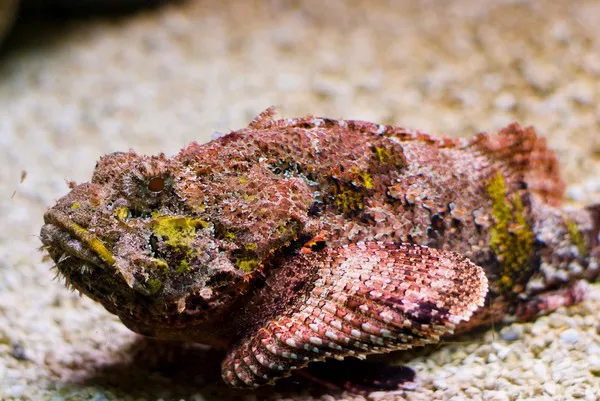The world beneath the ocean’s surface is a mesmerizing tapestry of life, with a plethora of species showcasing unique adaptations for survival. Among the vast array of marine life, some fish possess a deadly secret – they are armed with potent toxins that can prove fatal to predators, including humans. In this exploration, we’ll dive into the depths of the ocean to uncover the 10 most poisonous fish, examining their fascinating adaptations, habitats, and the risks they pose to those who encounter them.
10 Most Poisonous Fish in the World
1. Stonefish (Synanceia spp.)
The Stonefish earns its reputation as one of the most venomous fish in the world, thanks to its remarkable ability to blend seamlessly with its surroundings. Found in the Indo-Pacific region, these masters of camouflage often rest on the ocean floor, resembling rocks or coral. The venomous spines on their dorsal fin release potent toxins when disturbed, causing excruciating pain, tissue necrosis, and even death if not promptly treated.
2. Boxfish (Ostraciidae family)
Known for their distinctive box-like appearance, boxfishes are a family of fish that inhabit tropical and subtropical waters. While their striking geometric shapes and vibrant colors make them popular choices for aquariums, these fish produce a toxin called pahutoxin. In confined spaces, such as aquariums, the release of pahutoxin can be lethal to other fish. Handling boxfish without proper precautions can also lead to skin irritation and poisoning in humans.
3. Pufferfish (Tetraodontidae family)
The pufferfish, or fugu as it is known in Japan, is infamous for containing tetrodotoxin, a potent neurotoxin that can cause paralysis and death. Despite its lethal potential, pufferfish is considered a delicacy in Japan, where only licensed chefs are allowed to prepare it. The liver, skin, and certain organs of the pufferfish are particularly toxic, and accidental ingestion can lead to respiratory failure. Strict regulations govern the preparation and serving of pufferfish to ensure consumer safety.
4. Lionfish (Pterois spp.)
Known for their striking appearance with feathery pectoral fins and vibrant colors, lionfish are popular in the aquarium trade. However, their beauty hides a danger – venomous spines along their dorsal, pelvic, and anal fins. Lionfish deliver venom when threatened, causing intense pain, nausea, and, in rare cases, respiratory distress. Native to the Indo-Pacific, lionfish have become an invasive species in the Atlantic, where their venomous presence poses a threat to local marine ecosystems.
5. Crown-of-Thorns Starfish (Acanthaster planci)
While not a fish, the crown-of-thorns starfish deserves inclusion for its impact on coral reefs and its venomous spines. These starfish feed on coral polyps and can cause extensive damage to coral reefs when their populations surge. The spines of the crown-of-thorns starfish contain a potent venom that can cause severe pain, swelling, and, in some cases, systemic effects. Handling these starfish without protective gear is ill-advised due to the risk of envenomation.
6. Scorpionfish (Scorpaenidae family)
With their elaborate camouflage and spiky appearance, scorpionfish are masters of blending into their surroundings on the ocean floor. Found in both tropical and temperate waters, these fish possess venomous spines on their dorsal and anal fins. The venom causes intense pain, swelling, and sometimes systemic effects. Due to their ability to remain concealed, accidental encounters with scorpionfish are not uncommon, emphasizing the need for caution when exploring reef environments.
7. Globe Fish (Tetraodontidae family)
Distinct from the pufferfish, globe fish are also part of the Tetraodontidae family and share the potential for tetrodotoxin toxicity. Found in tropical and subtropical waters, globe fish have a more rounded body shape. Similar to pufferfish, ingestion of certain organs, such as the liver, can lead to tetrodotoxin poisoning. The risk of poisoning has led to stringent regulations governing the sale and preparation of globe fish in regions where they are consumed.
8. Scorpionfish (Synanceia verrucosa)
Belonging to the same family as the stonefish, the reef stonefish is another highly venomous member. Endemic to the Indo-Pacific region, these fish are masters of disguise, often resembling rocks or coral. Their potent venom, delivered through dorsal fin spines, can cause intense pain, swelling, and tissue necrosis. Proper reef-walking precautions and awareness are crucial to avoiding accidental encounters with the reef stonefish.
9. Rabbitfish (Siganidae family)
Rabbitfish, also known as spinefoot fish, inhabit coral reefs in the Indo-Pacific region. While their name might suggest harmlessness, rabbitfish possess venomous spines on their dorsal and anal fins. When threatened, these fish can deliver a painful sting, and their venom can cause swelling and discomfort in humans. While encounters with rabbitfish are generally not life-threatening, the pain and potential for infection emphasize the importance of caution.
10. Electric Catfish (Malapteruridae family)
Found in freshwater habitats across Africa, electric catfish are unique in their ability to generate electric shocks for communication and navigation. While their electric discharges are not lethal, they can cause discomfort and muscle spasms in humans. The electric catfish’s ability to generate electrical fields also plays a role in hunting and self-defense. Although not directly toxic, the electric catfish serves as a reminder of the diverse and sometimes surprising adaptations found in the aquatic world.
Conclusion
The underwater realm is home to an astonishing variety of fish, many of which possess potent toxins for self-defense. Understanding the risks associated with encounters with these poisonous fish is crucial for both marine enthusiasts and those who rely on the sea for sustenance. As we explore the mysteries of the ocean, it is essential to appreciate the delicate balance of marine ecosystems and to approach these fascinating creatures with the respect and caution they deserve.
You Might Be Interested In:


























